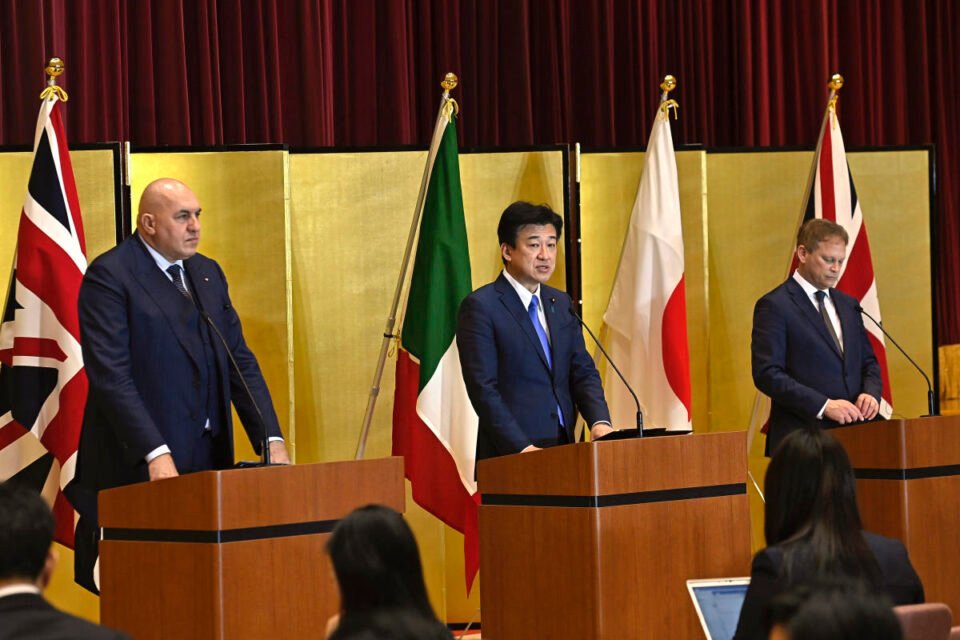TOKYO (AP) — Japan’s Cabinet OK’d a plan to sell future next-generation fighter jets to other countries on Tuesday, its latest step away from the pacifist principles the country adopted at the end of World War II.
The controversial decision to allow international arms sales is expected to help secure Japan’s role in a year-old project to develop a new fighter jet together with Italy and the U.K., but it’s also part of a move to build up Japan’s arms industry and bolster its role in global affairs.
For now, Tokyo says that it doesn’t plan to export co-developed lethal weapons other than the new fighters, which aren’t expected to enter service until 2035.
Here is a look at what the latest change is about and why Japan is rapidly easing weapons export rules.
WHAT’S CHANGING?
On Tuesday, the Cabinet approved a revision to its guidelines for selling defense equipment overseas, and authorized sales of the future jet. The government says that it has no plans to export other co-developed lethal weapons under the guidelines, and it would require Cabinet approval to do so.
Japan has long prohibited most arms exports under the country’s pacifist constitution, although it’s begun to take steps toward a change amid rising regional and global tensions. In 2014, it began to export some non-lethal military supplies, and last December, it approved a change that would allow sales of 80 lethal weapons and components that it manufactures under licenses from other countries back to the licensors. The change, which was made in December, cleared the way for Japan to sell U.S.-designed Patriot missiles to the United States, helping replace munitions that Washington is sending to Ukraine.
The decision on jets will allow Japan to export lethal weapons it co-produces to other countries for the first time.
WHAT IS THE NEW FIGHTER JET?
Japan is working with Italy and the U.K. to develop an advanced fighter jet to replace its aging fleet of American-designed F-2 fighters, and the Eurofighter Typhoons used by the U.K. and Italian militaries.
Japan, which was previously working on a homegrown design to be called the F-X, agreed in December 2022 to merge its effort with a British-Italian program called the Tempest. The joint project, known as the Global Combat Air Program, is based in the U.K., and hasn’t yet announced a new name for its design.
Japan hopes the new plane will offer better sensing and stealth capabilities amid growing tensions in the region, giving it a technological edge against regional rivals China and Russia.
WHY IS JAPAN CHANGING ITS STANCE ON ARMS EXPORTS?
In its decision, the Cabinet said that the ban on exporting finished products would hinder efforts to develop the new jet, and limit Japan to a supporting role in the project. Italy and the U.K. are eager to make sells of the jet in order to defray development and manufacturing costs.
U.K. Defense Minister Grant Shapps has repeatedly said Japan needs “updating” to not cause the project to stall.
Kishida sought Cabinet approval before signing the GCAP agreement in February, but it was delayed by resistance from his junior coalition partner, the Buddhist-backed Komeito party.
Exports would also help boost Japan’s defense industry, which historically has catered only to the country’s Self Defense Force, as Kishida seeks to build up the military. Japan began opening the door to some exports in 2014, but the industry has still struggled to win customers.
The change also comes as Kishida is planning an April state visit to Washington, where he is expected to stress Japan’s readiness to take a greater role in military and defense industry partnerships.
Japan sees China’s rapid military buildup and its increasing assertiveness as threats, especially growing tensions in the disputed East and South China Seas. Japan also sees increasing joint military exercises between China and Russia around Japan as a threat.
WHY ARE ARMS EXPORTS DIVISIVE?
Because of its wartime past as an aggressor and the devastation that followed its defeat in World War II, Japan adopted a constitution that limits its military to self-defense and long maintained a strict policy to limit transfers of military equipment and technology and ban all exports of lethal weapons.
Opposition lawmakers and pacifist activists have criticized Kishida’s government for committing to the fighter jet project without explaining to the public or seeking approval for the major policy change.
Recent polls show public opinion is divided on the plan.
To address such concerns, the government is limiting exports of co-developed lethal weapons to the jet for now, and has promised that no sales will be made for use in active wars. If a purchaser begins using the jets for war, Defense Minister Minoru Kihara said, Japan will stop providing spare parts and other components.
WHAT’S NEXT?
Potential markets for the jet include the 15 countries with which Japan has defense partnership agreements, such as the United States, Germany, India and Vietnam. A defense official said Taiwan — a self-governed island that China claims as its own territory — is not being considered. He spoke on condition of anonymity due to briefing rules.
More weapons and components could be added to the approved list under the new export guidelines.
When Kishida goes to Washington in April, he’s likely to talk to U.S. leaders about potential new defense and weapons industry cooperation. The new policy could also help Japan push for a bigger role in alliances and regional defense partnerships like Australia, the U.S. and the U.K.’s AUKUS.
___
Follow AP’s Asia-Pacific coverage at https://apnews.com/hub/asia-pacific

